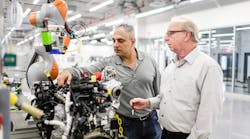In the 1936 satire Modern Times, Charlie Chaplin stars as a hapless factory worker tightening bolt after bolt after bolt of a large industrial machine until he is eventually pulled into—and run through—its gears.Bottom of Form
However silly, Chaplin’s film reflects a legitimate concern that Adam Waytz has about the changing relationship between people and technology. Namely, as technology becomes more ubiquitous in the workplace, and more jobs are directly impacted by automation, what happens to the humans? Do we become an afterthought? Or can workplaces—can work itself—adapt to become productive and humane?
Waytz is a professor of management and organizations at the Kellogg School and the author of The Power of Human (from which you can read an excerpt here). In his research, Waytz studies what the future of work might look like. Here he shares three ways humans and machines can work together to benefit both organizations and their employees.
Get the Division of Labor Right
The trend toward automation is often discussed in terms of the financial and practical benefits of a division of labor: When are machines better equipped to tackle a task than humans, and when is the reverse true?
Generally speaking, “the idea is to let robotics do the dull, rote stuff of sifting through data, and then let humans provide their specific expertise,” says Waytz. “People have the ability to go off script, the ability to deal with nonroutine information, outliers in the data.”
In practice, a cybersecurity platform might use AI to sift through millions of pieces of data to pinpoint cybersecurity threats. Yet, if left on its own, that same AI application could be prone to spit out lots of false positives. It’s here that human security experts could intervene to assess the outliers, giving the machine the opportunity to better learn how to identify security threats from the new human input.
This makes a lot of sense. But Waytz also suggests that this division of labor should take into account the moral strengths of both people and machines—not just what each can contribute, but what we as humans believe each party should contribute.
For instance, we generally don’t mind robots making utilitarian calculations—in fact, we often approve of the increased objectivity that comes with robotic cost-benefit assessments. But humans may be better trusted to consider specific aspects of those calculations, such as whether people are discriminated against or physically harmed by a decision.
Say, for example, your business is working on an algorithm to roll out goods efficiently. Eventually, you will need people to step in to ensure that real human needs are being met, or what unintended consequences may come along with the decisions the machine is reaching.
“You still need a human working on that algorithm to say, okay, are we bringing goods to all the right neighborhoods? Are we discriminating against any neighborhoods? Is anyone missing from our delivery routes? Things like that,” Waytz says.
The flip side of this is that companies should not hesitate to outsource to robots certain kinds of emotionally taxing work, such as helping frustrated customers who call for technical assistance or using biometrics software to verify their identities and properly route their calls. Doing so eases the burden on customers and helps reduce employee burnout caused by managing one’s emotions.
Encourage Humans to Double Down on Human Qualities
Companies considering the qualities of human and machine interactions should make sure human work encompass not just what we can and should do, but also what we find invigorating and meaningful. This, says Waytz, is good for employees and ultimately for businesses.
One such quality is variety, which is why organizations should expand the array of tasks people do and the skills they are encouraged to flex. For example, Zappos trains its customer service operators not to work from scripts—after all, chatbots can do that. Instead, operators are simply instructed to handle calls to the best of their abilities. The result is a higher sense of agency and empowerment for Zappos’s employees and a reputation for great customer service among the company’s clients.
Giving people a variety of work can also fight employee burnout, a condition the World Health Organization has recently recognized as an “occupational phenomenon.”
Another human quality worth doubling down on is sociability, or fostering connections among people. “Robots have not caught up with us yet on social intelligence, empathy, or the ability and willingness of people to interact and understand each other,” Waytz says.
To boost sociability, some companies have focused on connecting workers with those who benefit from their products. Others have created pro-social bonuses, where a portion of employees’ bonuses is donated to charities of their choosing. Waytz says these ways of adding “social character” to compensation structures are often popular with employees.
“If you can activate the idea that there’s a beneficiary of your work and make that top of mind for people, they feel more purpose and they work harder.”
Plan for a Future with Less Labor and More Leisure
Finally, in a world where much of the time-consuming monotony of production is being taken on by machines, people should have greater opportunities for leisure, says Waytz. Providing time away will increase employees’ well-being. It will also keep employees engaged and sharp.
Waytz describes this as, “committing seriously to leisure.”
But to make this a reality, organizations need to place more emphasis on actual leisure—allowing workers to leave the office entirely to refresh. Workplaces that attempt to build leisure opportunities into the workspace itself to keep their employees on-site may be doing themselves, and their employees, a disservice. Because even though amenities like food trucks, foosball tables, and extensive schedules of social events may seem really cool, they are still at work.
“The key for organizations is to get away from needing to control employees at all times and let them disengage,” Waytz says.
Instead, workplaces should expand vacation offerings or dial back expectations that employees check email outside of business hours. These are not extreme measures—Waytz isn’t advocating for the two-day work week—but ways to reinforce the recognition of employees’ humanity in an increasingly mechanized workplace.
A future with more leisure will require organizations to reprioritize work cultures and deemphasize Americans’ “more is better” views about work. This cultural shift may be rather difficult and will require brave leadership from company leaders. But the less we collectively assess human worth in instrumental or economic terms, says Waytz, the better off we will be.
This article originally appeared in Kellogg Insight, the publication of the Kellogg School of Management at Northwestern University. It is used with permission.





